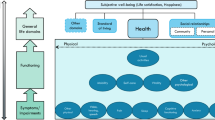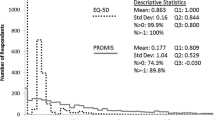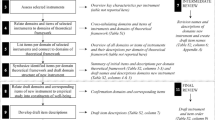Abstract
Purpose
The objective of this paper is to describe the four-stage methodology used to obtain utility scores for the Assessment of Quality of Life (AQoL)-8D, a 35-item 8 dimension multi-attribute utility instrument, which was created to achieve a high degree of sensitivity to psycho-social health.
Methods
Data for the analyses were obtained from a representative group of 347 members of the Australian public and from 323 mental health patients each of whom provided VAS and time trade-off valuations of multiple health states. Data were used initially to create multiplicative scoring algorithms for each of the instrument’s 8 dimensions and for the overall instrument. Each of the algorithms was then subject to a second-stage econometric ‘correction’.
Results
Algorithms were successfully created for each of the AQoL-8D’s dimensions, for physical and mental ‘super-dimensions’ and for the overall AQoL-8D instrument. The final AQoL-8D algorithm has good predictive power with respect to the TTO valuations.
Conclusions
The AQoL-8D is a suitable instrument for researchers conducting cost utility analyses generally but, in particular, for the analysis of services affecting psycho-social health.



Similar content being viewed by others
References
Brazier, J., Ratcliffe, J., Salomon, J., & Tsuchiya, A. (2007). Measuring and valuing health benefits for economic evaluation. Oxford: Oxford University Press.
Richardson, J., McKie, J., & Bariola, E. (2014). Multi attribute utility instruments and their use. In A. J. Culyer (Ed.), Encyclopedia of Health Economics. San Diego: Elsevier Science.
Moock, J., & Kohlmann, T. (2008). Comparing preference-based quality-of-life measures: Results from rehabilitation patients with musculoskeletal, cardiovascular, or psychosomatic disorders. Quality of Life Research, 17, 485–495.
Fryback, D. G., Palta, M., Cherepanov, D., Bolt, D., & Kim, J. (2010). Comparison of 5 health related quality of life indexes using item response theory analysis. Medical Decision Making, 30, 5–15.
Dolan, P., Lee, H., & Peasgood, T. (2012). Losing sight of the wood for the trees: Some issues in describing and valuing health, and another possible approach. Pharmacoeconomics, 30, 1035–1049.
Bowling, A. (1995). What things are important in people’s lives? A survey of the public’s judgements to inform scales of health related quality of life. Social Science and Medicine, 41, 1447–1462.
Helliwell, J., Layard, R., & Sachs, J. (2012). World happiness report. New York: Earth Institute, Columbia University. http://www.earthinstitute.columbia.edu/articles/view/2960 (Accessed April 30, 2012).
Richardson, J., Day, N. A., Peacock, S., & Iezzi, A. (2004). Measurement of the quality of life for economic evaluation and the Assessment of Quality of Life (AQoL) mark 2 instrument. Australian Economic Review, 37, 62–88.
Richardson, J., Elsworth, G., Iezzi, A., Khan, M. A., Mihalopoulos, C., Schweitzer, I., et al. (2011). Increasing the sensitivity of the AQoL inventory for evaluation of interventions affecting mental health, research paper 61. Melbourne: Centre for Health Economics, Monash University.
McDonald, R. P. (2005). Semiconfirmatory factor analysis: The example of anxiety and depression. Structural Equation Modeling: A Multidisciplinary Journal, 12, 163–172.
Sintonen, H., & Pekurinen, M. (1989). A generic 15 dimensional measure of health-related quality of life (15D). Journal of Social Medicine, 26, 85–96.
Torrance, G., Boyle, M., & Horwood, S. (1982). Application of multi-attribute utility theory to measure social preferences for health status. Operations Research, 30, 1043–1069.
Feeny, D., Furlong, W., & Torrance, G. (1996). Health Utilities Index Mark 2 and Mark 3 (HUI 2/3) 15 item questionnaire for self-administered, self assessed usual health status. Hamilton, ON: Centre for Health Economics and Policy Analysis, McMaster University.
Feeny, D., Furlong, W., Torrance, G., Goldsmith, C., Zhu, Z., DePauw, S., et al. (2002). Multi attribute and single attribute utility functions for the Health Utilities Index Mark 3 system. Medical Care, 40, 113–128.
Hawthorne, G., Richardson, J., & Osborne, R. (1999). The Assessment of Quality of Life (AQoL) instrument: A psychometric measure of health related quality of life. Quality of Life Research, 8, 209–224.
Von Winterfeldt, D., & Edwards, W. (1986). Decision analysis and behavioral research. Cambridge: Cambridge University Press.
Dolan, P. (1997). Modeling valuations for EuroQol health states. Medical Care, 35, 1095–1108.
Brazier, J., Roberts, J., & Deverill, M. (2002). The estimation of a preference-based measure of health from the SF-36. Journal of Health Economics, 21, 271–292.
Cronbach, L. J. (1971). Test validation. In R. L. Thorndike (Ed.), Educational measurement (2nd ed.). Washington, DC: American Council on Education.
Streiner, D., & Norman, G. R. (2003). Health measurement scales: A practical guide to their development and use. Oxford: Oxford University Press.
Iezzi, A., & Richardson, J. (2009). Measuring quality of life at the CHE: Description of instruments, interview props and their administration, research paper 41. Melbourne: Centre for Health Economics, Monash University.
Richardson, J., Iezzi, A., Khan, M. A., Sinha, K., Mihalopoulos, C., Herrman, H., et al. (2009). Data used in the development of the AQoL-8D (PsyQoL) quality of life instrument, research paper 40. Melbourne: Centre for Health Economics, Monash University.
Hoinville, G., Jowell, R., Airey, C., Brook, J., Courtenay, G., Hedges, B., et al. (1977). Survey research practice. London: Heinemann Educational Books.
Richardson, J., & AQoL Group. (2013). Assessment of Quality of Life (AQoL) users (Vol. 2013). http://www.aqol.com.au/index.php/aqoluserinfo. (Melbourne: http://www.aqol.com.au/).
Richardson, J., Khan, M. A., Iezzi, A., & Maxwell, A. (2012). Cross-national comparison of twelve quality of life instruments. Research Papers 78, 80–83, 85. MIC Report: 2: Australia; 3: UK; 4: USA; 5: Canada; 6: Norway; 7: Germany. Melbourne: Centre for Health Economics, Monash University. http://www.buseco.monash.edu.au/centres/che/che-publications.html (Accessed January 25, 2013).
Richardson, J., Iezzi, A., Khan, M. A., & Maxwell, A. (2013). Validity and reliability of the Assessment of Quality of Life (AQoL-8D) multi attribute utility instrument. The Patient: Patient-Centered Outcomes Research. doi:10.1007/s40271-013-0036-x.
Richardson, J., Khan, M. A., Chen, G., Iezzi, A., & Maxwell, A. (2012). Population norms and Australian profile using the Assessment of Quality of Life (AQoL) 8D utility instrument, research paper 72. Melbourne: Centre for Health Economics, Monash University.
ABS. (2013). Australian demographic statistics, population by age and sex, Cat 3201.0. Canberra: Australian Bureau of Statistics. http://www.abs.gov.au/AUSSTATS/abs@.nsf/DetailsPage/3201.0Jun%202010?OpenDocument (Accessed August 12, 2013).
Author information
Authors and Affiliations
Corresponding author
Electronic supplementary material
Below is the link to the electronic supplementary material.
Rights and permissions
About this article
Cite this article
Richardson, J., Sinha, K., Iezzi, A. et al. Modelling utility weights for the Assessment of Quality of Life (AQoL)-8D. Qual Life Res 23, 2395–2404 (2014). https://doi.org/10.1007/s11136-014-0686-8
Accepted:
Published:
Issue Date:
DOI: https://doi.org/10.1007/s11136-014-0686-8




